Volvo Group Business Model: Opportunities & Threats of Smart Products
VerifiedAdded on 2023/06/12
|7
|1960
|357
Essay
AI Summary
This essay defines business models and disruption, analyzing the opportunities and threats presented by smart connected products to a company's business model, using the Osterwalder & Pigneur (2010) framework. It highlights how business models have evolved into complex tools for creating business value, emphasizing the importance of aligning them with business strategy and accommodating innovation. The essay focuses on Volvo Group, discussing how smart connected products offer opportunities for increased automobile safety, fuel efficiency, and intelligent maintenance, while also posing threats to information security and user privacy. Ultimately, it concludes that Volvo Group's business model is value proposition-oriented, aiming to drive prosperity through transport solutions, supported by key resources for delivering value to its customers.

UNIT
NAME
DATE:
NAME
DATE:
Paraphrase This Document
Need a fresh take? Get an instant paraphrase of this document with our AI Paraphraser
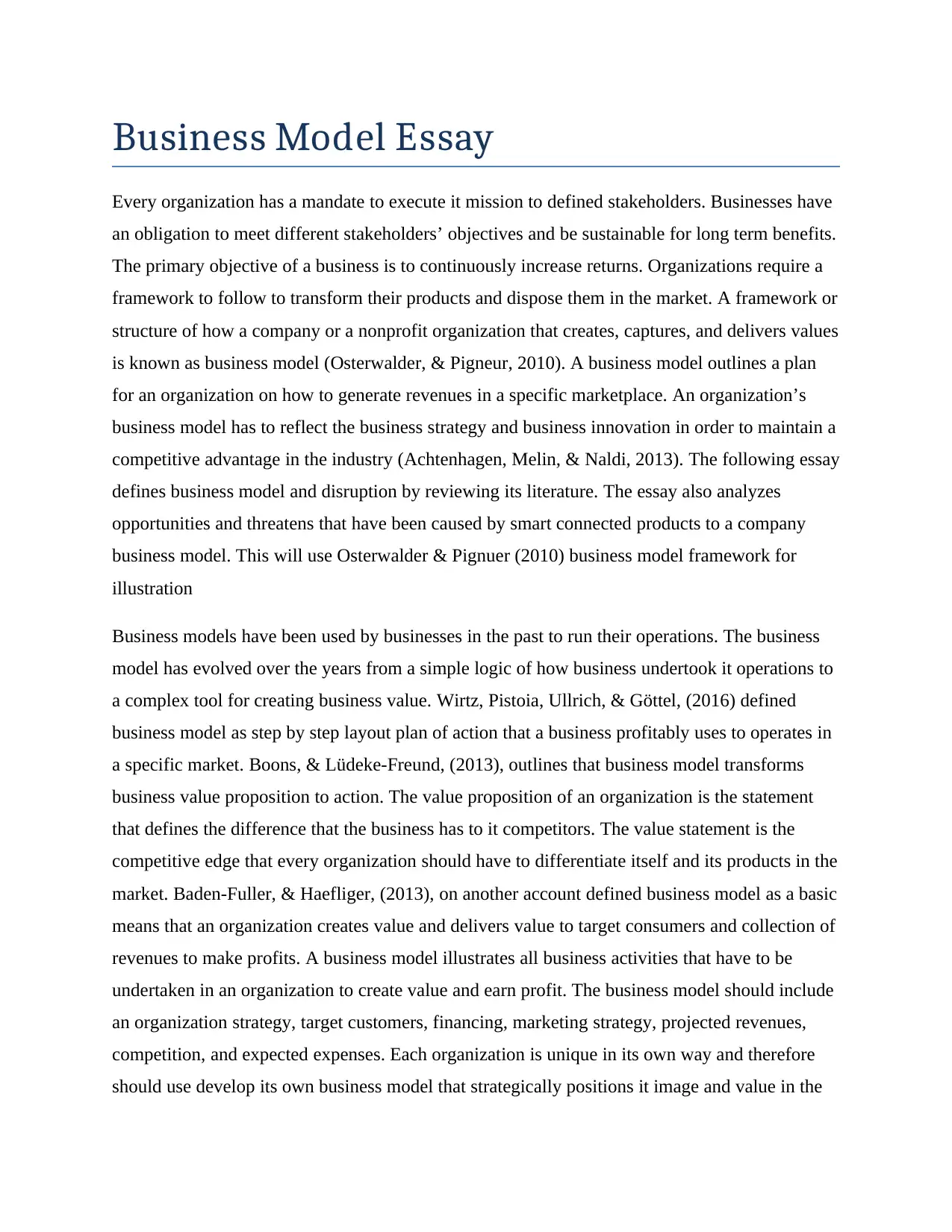
Business Model Essay
Every organization has a mandate to execute it mission to defined stakeholders. Businesses have
an obligation to meet different stakeholders’ objectives and be sustainable for long term benefits.
The primary objective of a business is to continuously increase returns. Organizations require a
framework to follow to transform their products and dispose them in the market. A framework or
structure of how a company or a nonprofit organization that creates, captures, and delivers values
is known as business model (Osterwalder, & Pigneur, 2010). A business model outlines a plan
for an organization on how to generate revenues in a specific marketplace. An organization’s
business model has to reflect the business strategy and business innovation in order to maintain a
competitive advantage in the industry (Achtenhagen, Melin, & Naldi, 2013). The following essay
defines business model and disruption by reviewing its literature. The essay also analyzes
opportunities and threatens that have been caused by smart connected products to a company
business model. This will use Osterwalder & Pignuer (2010) business model framework for
illustration
Business models have been used by businesses in the past to run their operations. The business
model has evolved over the years from a simple logic of how business undertook it operations to
a complex tool for creating business value. Wirtz, Pistoia, Ullrich, & Göttel, (2016) defined
business model as step by step layout plan of action that a business profitably uses to operates in
a specific market. Boons, & Lüdeke-Freund, (2013), outlines that business model transforms
business value proposition to action. The value proposition of an organization is the statement
that defines the difference that the business has to it competitors. The value statement is the
competitive edge that every organization should have to differentiate itself and its products in the
market. Baden-Fuller, & Haefliger, (2013), on another account defined business model as a basic
means that an organization creates value and delivers value to target consumers and collection of
revenues to make profits. A business model illustrates all business activities that have to be
undertaken in an organization to create value and earn profit. The business model should include
an organization strategy, target customers, financing, marketing strategy, projected revenues,
competition, and expected expenses. Each organization is unique in its own way and therefore
should use develop its own business model that strategically positions it image and value in the
Every organization has a mandate to execute it mission to defined stakeholders. Businesses have
an obligation to meet different stakeholders’ objectives and be sustainable for long term benefits.
The primary objective of a business is to continuously increase returns. Organizations require a
framework to follow to transform their products and dispose them in the market. A framework or
structure of how a company or a nonprofit organization that creates, captures, and delivers values
is known as business model (Osterwalder, & Pigneur, 2010). A business model outlines a plan
for an organization on how to generate revenues in a specific marketplace. An organization’s
business model has to reflect the business strategy and business innovation in order to maintain a
competitive advantage in the industry (Achtenhagen, Melin, & Naldi, 2013). The following essay
defines business model and disruption by reviewing its literature. The essay also analyzes
opportunities and threatens that have been caused by smart connected products to a company
business model. This will use Osterwalder & Pignuer (2010) business model framework for
illustration
Business models have been used by businesses in the past to run their operations. The business
model has evolved over the years from a simple logic of how business undertook it operations to
a complex tool for creating business value. Wirtz, Pistoia, Ullrich, & Göttel, (2016) defined
business model as step by step layout plan of action that a business profitably uses to operates in
a specific market. Boons, & Lüdeke-Freund, (2013), outlines that business model transforms
business value proposition to action. The value proposition of an organization is the statement
that defines the difference that the business has to it competitors. The value statement is the
competitive edge that every organization should have to differentiate itself and its products in the
market. Baden-Fuller, & Haefliger, (2013), on another account defined business model as a basic
means that an organization creates value and delivers value to target consumers and collection of
revenues to make profits. A business model illustrates all business activities that have to be
undertaken in an organization to create value and earn profit. The business model should include
an organization strategy, target customers, financing, marketing strategy, projected revenues,
competition, and expected expenses. Each organization is unique in its own way and therefore
should use develop its own business model that strategically positions it image and value in the
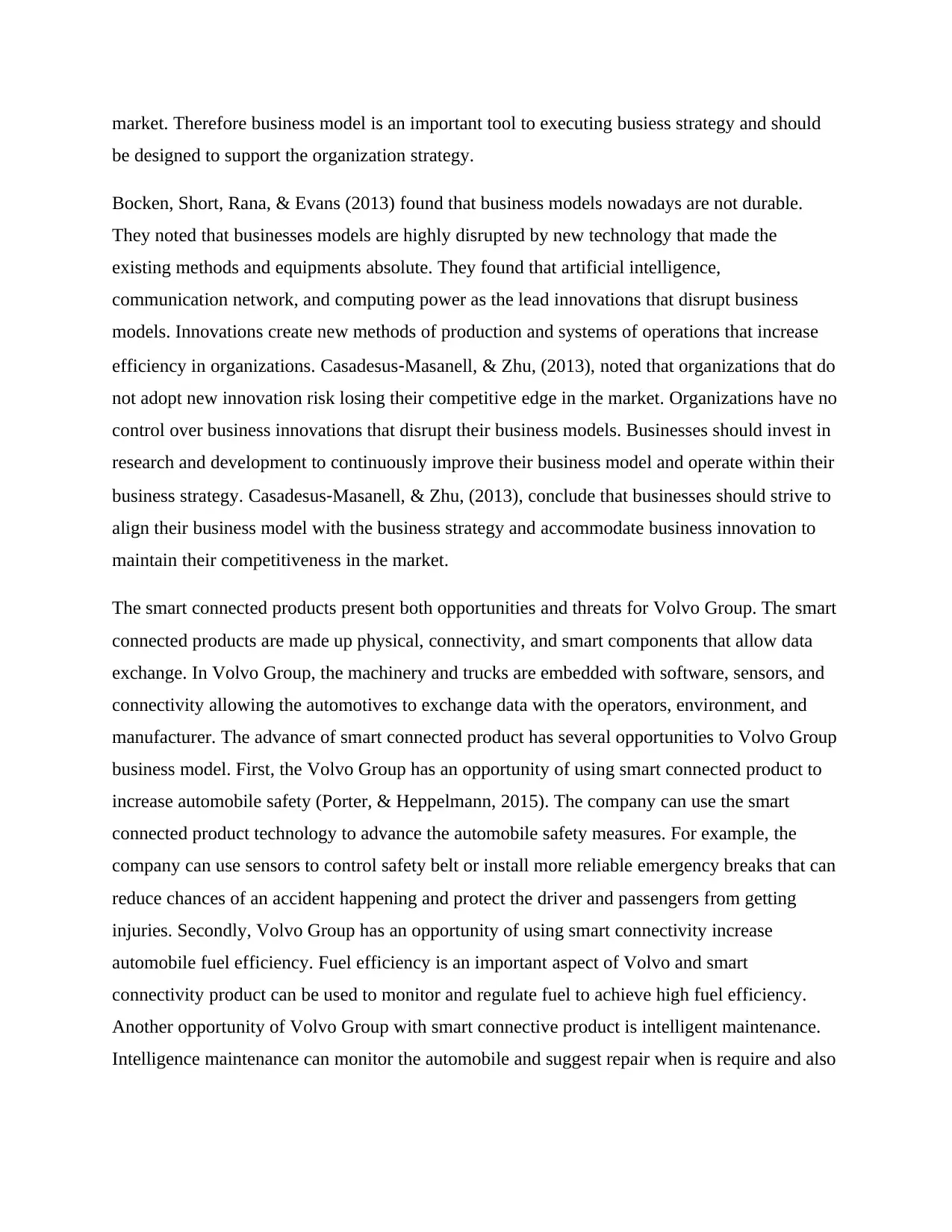
market. Therefore business model is an important tool to executing busiess strategy and should
be designed to support the organization strategy.
Bocken, Short, Rana, & Evans (2013) found that business models nowadays are not durable.
They noted that businesses models are highly disrupted by new technology that made the
existing methods and equipments absolute. They found that artificial intelligence,
communication network, and computing power as the lead innovations that disrupt business
models. Innovations create new methods of production and systems of operations that increase
efficiency in organizations. Casadesus‐Masanell, & Zhu, (2013), noted that organizations that do
not adopt new innovation risk losing their competitive edge in the market. Organizations have no
control over business innovations that disrupt their business models. Businesses should invest in
research and development to continuously improve their business model and operate within their
business strategy. Casadesus‐Masanell, & Zhu, (2013), conclude that businesses should strive to
align their business model with the business strategy and accommodate business innovation to
maintain their competitiveness in the market.
The smart connected products present both opportunities and threats for Volvo Group. The smart
connected products are made up physical, connectivity, and smart components that allow data
exchange. In Volvo Group, the machinery and trucks are embedded with software, sensors, and
connectivity allowing the automotives to exchange data with the operators, environment, and
manufacturer. The advance of smart connected product has several opportunities to Volvo Group
business model. First, the Volvo Group has an opportunity of using smart connected product to
increase automobile safety (Porter, & Heppelmann, 2015). The company can use the smart
connected product technology to advance the automobile safety measures. For example, the
company can use sensors to control safety belt or install more reliable emergency breaks that can
reduce chances of an accident happening and protect the driver and passengers from getting
injuries. Secondly, Volvo Group has an opportunity of using smart connectivity increase
automobile fuel efficiency. Fuel efficiency is an important aspect of Volvo and smart
connectivity product can be used to monitor and regulate fuel to achieve high fuel efficiency.
Another opportunity of Volvo Group with smart connective product is intelligent maintenance.
Intelligence maintenance can monitor the automobile and suggest repair when is require and also
be designed to support the organization strategy.
Bocken, Short, Rana, & Evans (2013) found that business models nowadays are not durable.
They noted that businesses models are highly disrupted by new technology that made the
existing methods and equipments absolute. They found that artificial intelligence,
communication network, and computing power as the lead innovations that disrupt business
models. Innovations create new methods of production and systems of operations that increase
efficiency in organizations. Casadesus‐Masanell, & Zhu, (2013), noted that organizations that do
not adopt new innovation risk losing their competitive edge in the market. Organizations have no
control over business innovations that disrupt their business models. Businesses should invest in
research and development to continuously improve their business model and operate within their
business strategy. Casadesus‐Masanell, & Zhu, (2013), conclude that businesses should strive to
align their business model with the business strategy and accommodate business innovation to
maintain their competitiveness in the market.
The smart connected products present both opportunities and threats for Volvo Group. The smart
connected products are made up physical, connectivity, and smart components that allow data
exchange. In Volvo Group, the machinery and trucks are embedded with software, sensors, and
connectivity allowing the automotives to exchange data with the operators, environment, and
manufacturer. The advance of smart connected product has several opportunities to Volvo Group
business model. First, the Volvo Group has an opportunity of using smart connected product to
increase automobile safety (Porter, & Heppelmann, 2015). The company can use the smart
connected product technology to advance the automobile safety measures. For example, the
company can use sensors to control safety belt or install more reliable emergency breaks that can
reduce chances of an accident happening and protect the driver and passengers from getting
injuries. Secondly, Volvo Group has an opportunity of using smart connectivity increase
automobile fuel efficiency. Fuel efficiency is an important aspect of Volvo and smart
connectivity product can be used to monitor and regulate fuel to achieve high fuel efficiency.
Another opportunity of Volvo Group with smart connective product is intelligent maintenance.
Intelligence maintenance can monitor the automobile and suggest repair when is require and also
⊘ This is a preview!⊘
Do you want full access?
Subscribe today to unlock all pages.

Trusted by 1+ million students worldwide
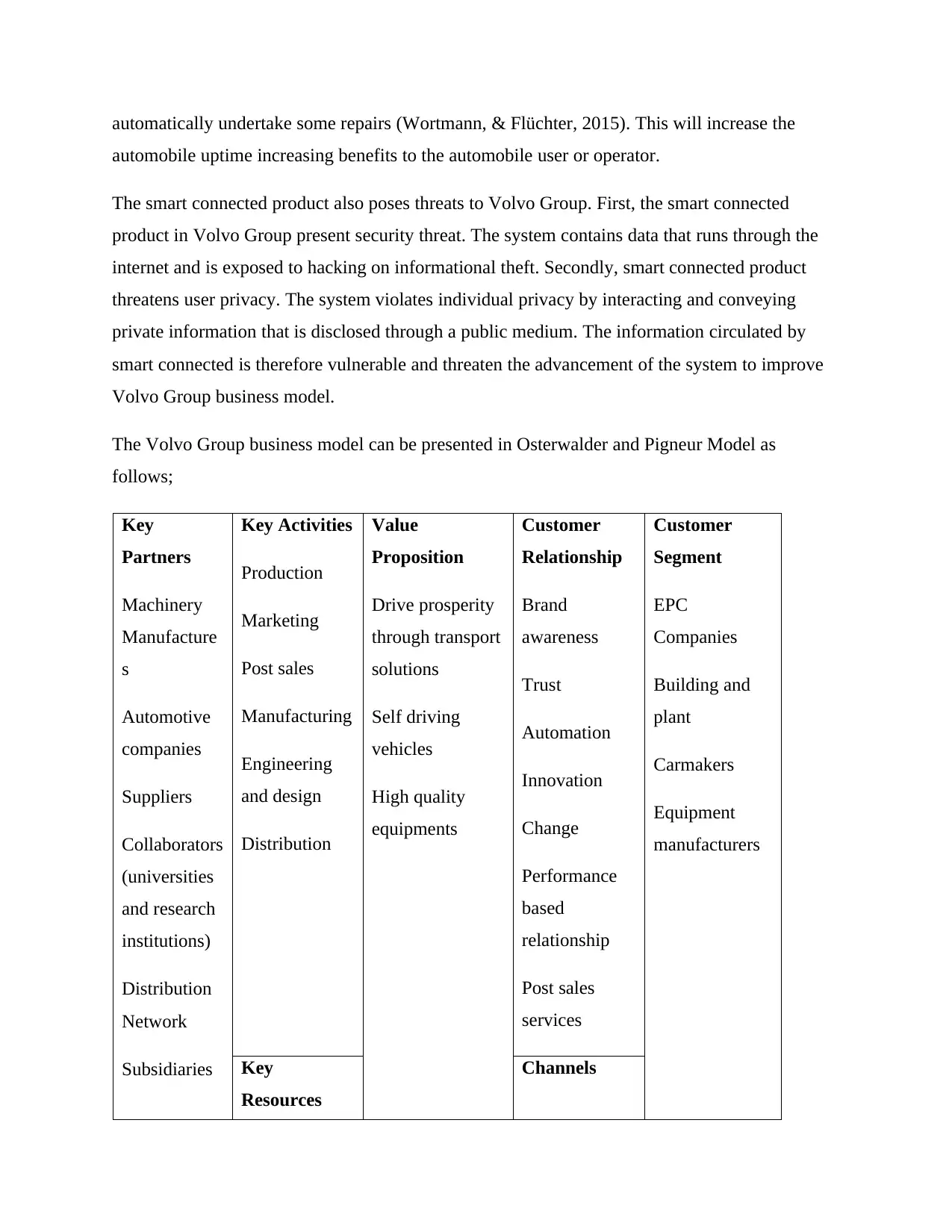
automatically undertake some repairs (Wortmann, & Flüchter, 2015). This will increase the
automobile uptime increasing benefits to the automobile user or operator.
The smart connected product also poses threats to Volvo Group. First, the smart connected
product in Volvo Group present security threat. The system contains data that runs through the
internet and is exposed to hacking on informational theft. Secondly, smart connected product
threatens user privacy. The system violates individual privacy by interacting and conveying
private information that is disclosed through a public medium. The information circulated by
smart connected is therefore vulnerable and threaten the advancement of the system to improve
Volvo Group business model.
The Volvo Group business model can be presented in Osterwalder and Pigneur Model as
follows;
Key
Partners
Machinery
Manufacture
s
Automotive
companies
Suppliers
Collaborators
(universities
and research
institutions)
Distribution
Network
Subsidiaries
Key Activities
Production
Marketing
Post sales
Manufacturing
Engineering
and design
Distribution
Value
Proposition
Drive prosperity
through transport
solutions
Self driving
vehicles
High quality
equipments
Customer
Relationship
Brand
awareness
Trust
Automation
Innovation
Change
Performance
based
relationship
Post sales
services
Customer
Segment
EPC
Companies
Building and
plant
Carmakers
Equipment
manufacturers
Key
Resources
Channels
automobile uptime increasing benefits to the automobile user or operator.
The smart connected product also poses threats to Volvo Group. First, the smart connected
product in Volvo Group present security threat. The system contains data that runs through the
internet and is exposed to hacking on informational theft. Secondly, smart connected product
threatens user privacy. The system violates individual privacy by interacting and conveying
private information that is disclosed through a public medium. The information circulated by
smart connected is therefore vulnerable and threaten the advancement of the system to improve
Volvo Group business model.
The Volvo Group business model can be presented in Osterwalder and Pigneur Model as
follows;
Key
Partners
Machinery
Manufacture
s
Automotive
companies
Suppliers
Collaborators
(universities
and research
institutions)
Distribution
Network
Subsidiaries
Key Activities
Production
Marketing
Post sales
Manufacturing
Engineering
and design
Distribution
Value
Proposition
Drive prosperity
through transport
solutions
Self driving
vehicles
High quality
equipments
Customer
Relationship
Brand
awareness
Trust
Automation
Innovation
Change
Performance
based
relationship
Post sales
services
Customer
Segment
EPC
Companies
Building and
plant
Carmakers
Equipment
manufacturers
Key
Resources
Channels
Paraphrase This Document
Need a fresh take? Get an instant paraphrase of this document with our AI Paraphraser
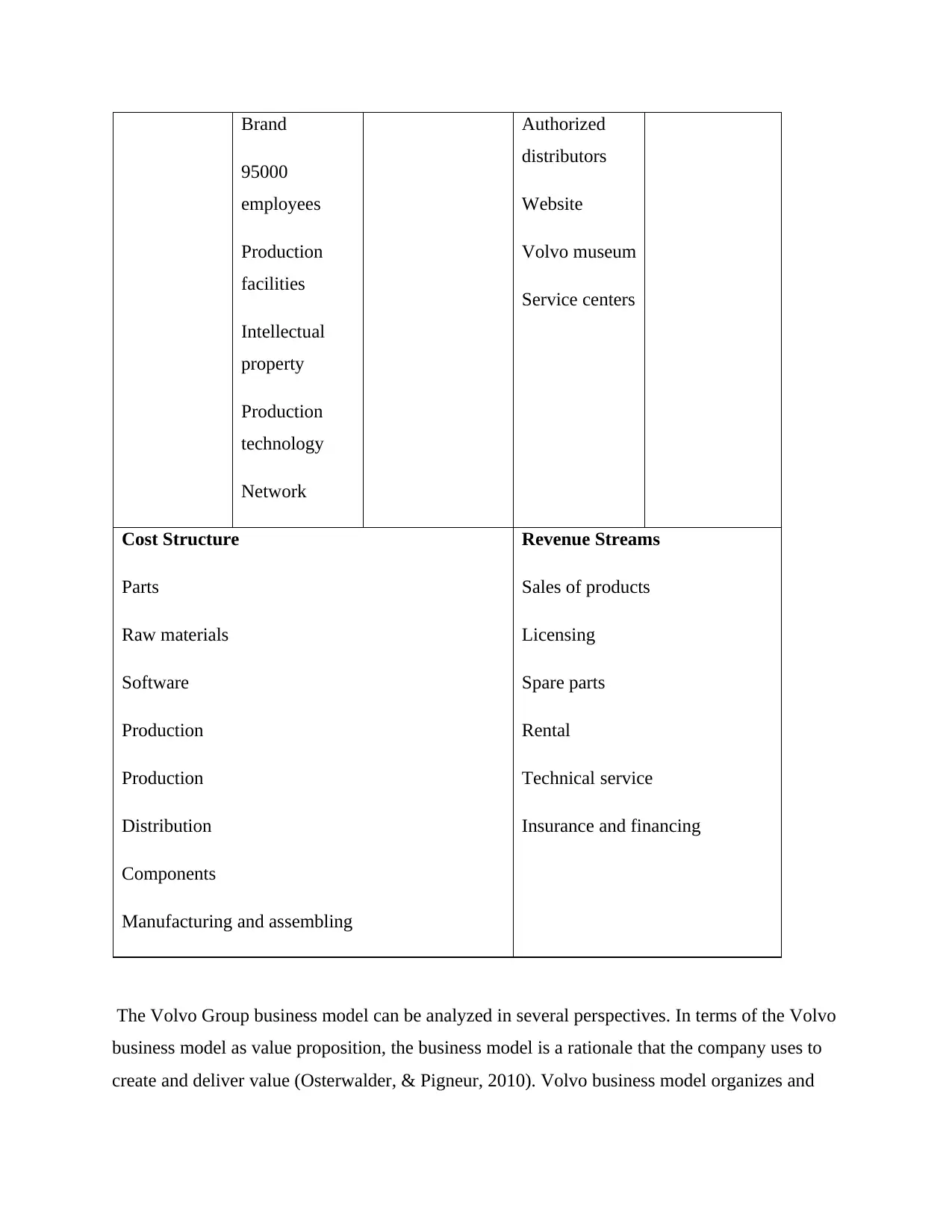
Brand
95000
employees
Production
facilities
Intellectual
property
Production
technology
Network
Authorized
distributors
Website
Volvo museum
Service centers
Cost Structure
Parts
Raw materials
Software
Production
Production
Distribution
Components
Manufacturing and assembling
Revenue Streams
Sales of products
Licensing
Spare parts
Rental
Technical service
Insurance and financing
The Volvo Group business model can be analyzed in several perspectives. In terms of the Volvo
business model as value proposition, the business model is a rationale that the company uses to
create and deliver value (Osterwalder, & Pigneur, 2010). Volvo business model organizes and
95000
employees
Production
facilities
Intellectual
property
Production
technology
Network
Authorized
distributors
Website
Volvo museum
Service centers
Cost Structure
Parts
Raw materials
Software
Production
Production
Distribution
Components
Manufacturing and assembling
Revenue Streams
Sales of products
Licensing
Spare parts
Rental
Technical service
Insurance and financing
The Volvo Group business model can be analyzed in several perspectives. In terms of the Volvo
business model as value proposition, the business model is a rationale that the company uses to
create and deliver value (Osterwalder, & Pigneur, 2010). Volvo business model organizes and
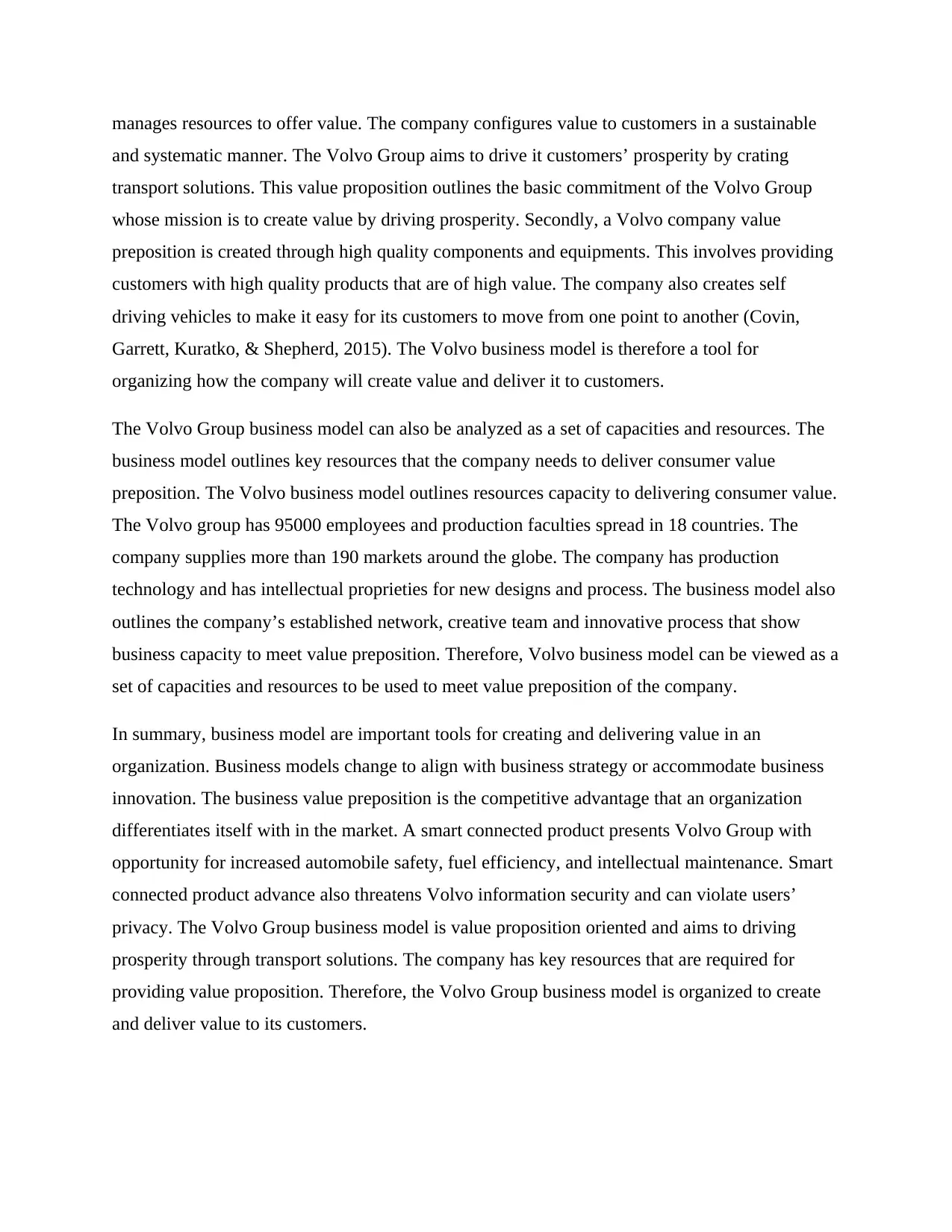
manages resources to offer value. The company configures value to customers in a sustainable
and systematic manner. The Volvo Group aims to drive it customers’ prosperity by crating
transport solutions. This value proposition outlines the basic commitment of the Volvo Group
whose mission is to create value by driving prosperity. Secondly, a Volvo company value
preposition is created through high quality components and equipments. This involves providing
customers with high quality products that are of high value. The company also creates self
driving vehicles to make it easy for its customers to move from one point to another (Covin,
Garrett, Kuratko, & Shepherd, 2015). The Volvo business model is therefore a tool for
organizing how the company will create value and deliver it to customers.
The Volvo Group business model can also be analyzed as a set of capacities and resources. The
business model outlines key resources that the company needs to deliver consumer value
preposition. The Volvo business model outlines resources capacity to delivering consumer value.
The Volvo group has 95000 employees and production faculties spread in 18 countries. The
company supplies more than 190 markets around the globe. The company has production
technology and has intellectual proprieties for new designs and process. The business model also
outlines the company’s established network, creative team and innovative process that show
business capacity to meet value preposition. Therefore, Volvo business model can be viewed as a
set of capacities and resources to be used to meet value preposition of the company.
In summary, business model are important tools for creating and delivering value in an
organization. Business models change to align with business strategy or accommodate business
innovation. The business value preposition is the competitive advantage that an organization
differentiates itself with in the market. A smart connected product presents Volvo Group with
opportunity for increased automobile safety, fuel efficiency, and intellectual maintenance. Smart
connected product advance also threatens Volvo information security and can violate users’
privacy. The Volvo Group business model is value proposition oriented and aims to driving
prosperity through transport solutions. The company has key resources that are required for
providing value proposition. Therefore, the Volvo Group business model is organized to create
and deliver value to its customers.
and systematic manner. The Volvo Group aims to drive it customers’ prosperity by crating
transport solutions. This value proposition outlines the basic commitment of the Volvo Group
whose mission is to create value by driving prosperity. Secondly, a Volvo company value
preposition is created through high quality components and equipments. This involves providing
customers with high quality products that are of high value. The company also creates self
driving vehicles to make it easy for its customers to move from one point to another (Covin,
Garrett, Kuratko, & Shepherd, 2015). The Volvo business model is therefore a tool for
organizing how the company will create value and deliver it to customers.
The Volvo Group business model can also be analyzed as a set of capacities and resources. The
business model outlines key resources that the company needs to deliver consumer value
preposition. The Volvo business model outlines resources capacity to delivering consumer value.
The Volvo group has 95000 employees and production faculties spread in 18 countries. The
company supplies more than 190 markets around the globe. The company has production
technology and has intellectual proprieties for new designs and process. The business model also
outlines the company’s established network, creative team and innovative process that show
business capacity to meet value preposition. Therefore, Volvo business model can be viewed as a
set of capacities and resources to be used to meet value preposition of the company.
In summary, business model are important tools for creating and delivering value in an
organization. Business models change to align with business strategy or accommodate business
innovation. The business value preposition is the competitive advantage that an organization
differentiates itself with in the market. A smart connected product presents Volvo Group with
opportunity for increased automobile safety, fuel efficiency, and intellectual maintenance. Smart
connected product advance also threatens Volvo information security and can violate users’
privacy. The Volvo Group business model is value proposition oriented and aims to driving
prosperity through transport solutions. The company has key resources that are required for
providing value proposition. Therefore, the Volvo Group business model is organized to create
and deliver value to its customers.
⊘ This is a preview!⊘
Do you want full access?
Subscribe today to unlock all pages.

Trusted by 1+ million students worldwide
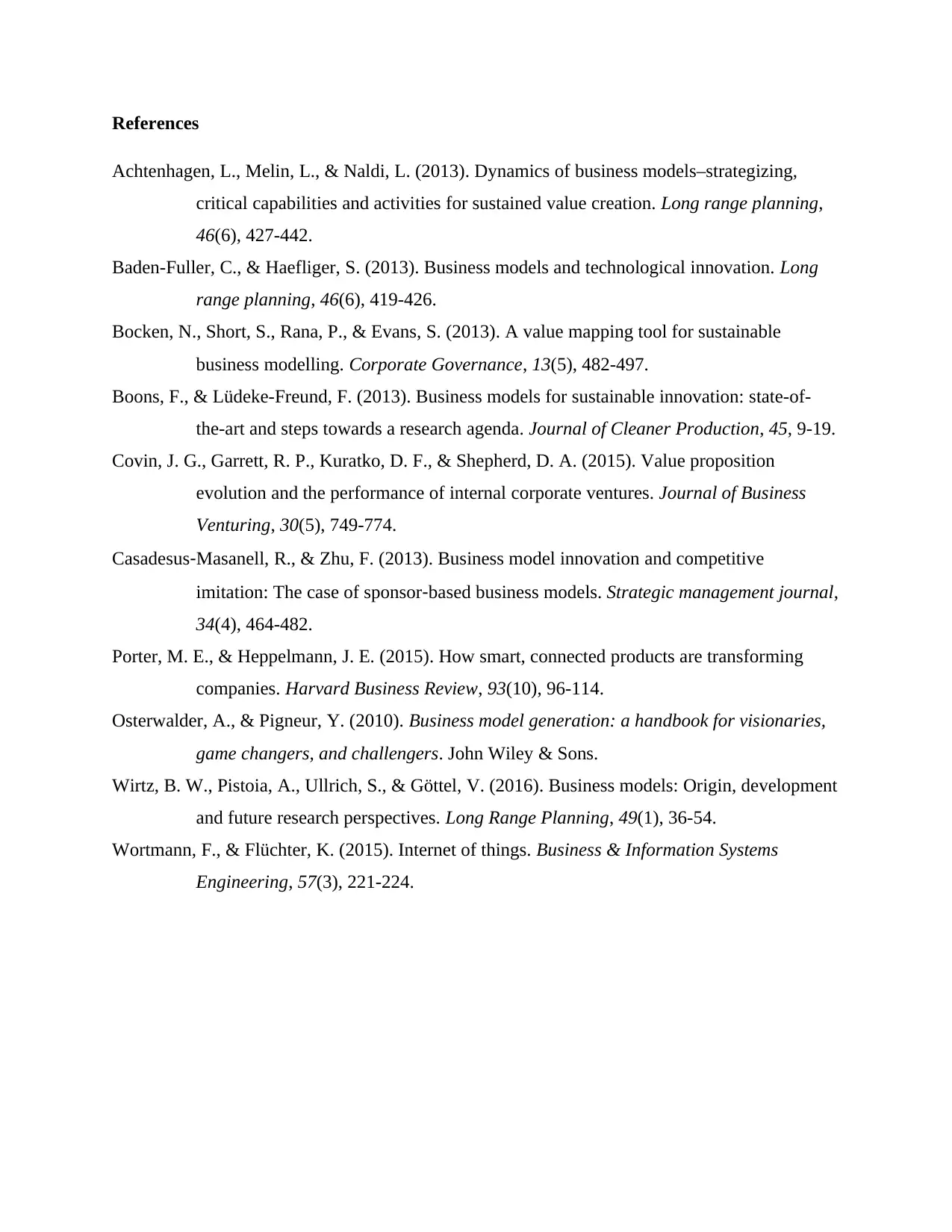
References
Achtenhagen, L., Melin, L., & Naldi, L. (2013). Dynamics of business models–strategizing,
critical capabilities and activities for sustained value creation. Long range planning,
46(6), 427-442.
Baden-Fuller, C., & Haefliger, S. (2013). Business models and technological innovation. Long
range planning, 46(6), 419-426.
Bocken, N., Short, S., Rana, P., & Evans, S. (2013). A value mapping tool for sustainable
business modelling. Corporate Governance, 13(5), 482-497.
Boons, F., & Lüdeke-Freund, F. (2013). Business models for sustainable innovation: state-of-
the-art and steps towards a research agenda. Journal of Cleaner Production, 45, 9-19.
Covin, J. G., Garrett, R. P., Kuratko, D. F., & Shepherd, D. A. (2015). Value proposition
evolution and the performance of internal corporate ventures. Journal of Business
Venturing, 30(5), 749-774.
Casadesus‐Masanell, R., & Zhu, F. (2013). Business model innovation and competitive
imitation: The case of sponsor‐based business models. Strategic management journal,
34(4), 464-482.
Porter, M. E., & Heppelmann, J. E. (2015). How smart, connected products are transforming
companies. Harvard Business Review, 93(10), 96-114.
Osterwalder, A., & Pigneur, Y. (2010). Business model generation: a handbook for visionaries,
game changers, and challengers. John Wiley & Sons.
Wirtz, B. W., Pistoia, A., Ullrich, S., & Göttel, V. (2016). Business models: Origin, development
and future research perspectives. Long Range Planning, 49(1), 36-54.
Wortmann, F., & Flüchter, K. (2015). Internet of things. Business & Information Systems
Engineering, 57(3), 221-224.
Achtenhagen, L., Melin, L., & Naldi, L. (2013). Dynamics of business models–strategizing,
critical capabilities and activities for sustained value creation. Long range planning,
46(6), 427-442.
Baden-Fuller, C., & Haefliger, S. (2013). Business models and technological innovation. Long
range planning, 46(6), 419-426.
Bocken, N., Short, S., Rana, P., & Evans, S. (2013). A value mapping tool for sustainable
business modelling. Corporate Governance, 13(5), 482-497.
Boons, F., & Lüdeke-Freund, F. (2013). Business models for sustainable innovation: state-of-
the-art and steps towards a research agenda. Journal of Cleaner Production, 45, 9-19.
Covin, J. G., Garrett, R. P., Kuratko, D. F., & Shepherd, D. A. (2015). Value proposition
evolution and the performance of internal corporate ventures. Journal of Business
Venturing, 30(5), 749-774.
Casadesus‐Masanell, R., & Zhu, F. (2013). Business model innovation and competitive
imitation: The case of sponsor‐based business models. Strategic management journal,
34(4), 464-482.
Porter, M. E., & Heppelmann, J. E. (2015). How smart, connected products are transforming
companies. Harvard Business Review, 93(10), 96-114.
Osterwalder, A., & Pigneur, Y. (2010). Business model generation: a handbook for visionaries,
game changers, and challengers. John Wiley & Sons.
Wirtz, B. W., Pistoia, A., Ullrich, S., & Göttel, V. (2016). Business models: Origin, development
and future research perspectives. Long Range Planning, 49(1), 36-54.
Wortmann, F., & Flüchter, K. (2015). Internet of things. Business & Information Systems
Engineering, 57(3), 221-224.
1 out of 7
Related Documents
Your All-in-One AI-Powered Toolkit for Academic Success.
+13062052269
info@desklib.com
Available 24*7 on WhatsApp / Email
![[object Object]](/_next/static/media/star-bottom.7253800d.svg)
Unlock your academic potential
Copyright © 2020–2025 A2Z Services. All Rights Reserved. Developed and managed by ZUCOL.


